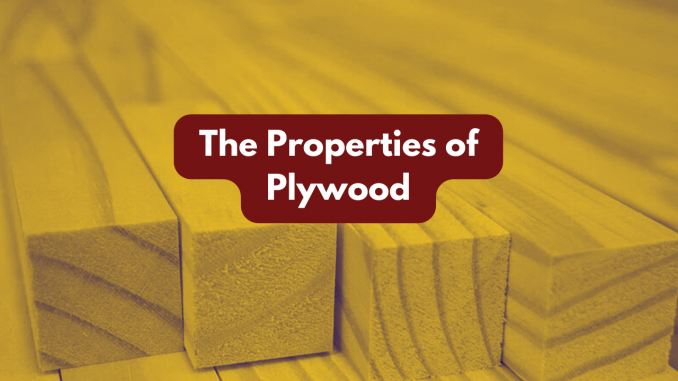
Plywood is a ubiquitous material in the world of construction and design, known for its durability, flexibility, and affordability. It’s often considered the unsung hero of the building industry, offering an array of properties that make it a staple in a wide range of applications. We will delve into the properties of plywood, shedding light on its unique characteristics and the diverse areas in which it is employed.
The Different Types of Plywood
Plywood comes in various types, each designed for specific applications based on their unique properties and characteristics. Here’s a list of different types of plywood:
- Softwood Plywood: Made from softwood species like pine, fir, or cedar, this type of plywood is commonly used in construction and structural applications.
- Hardwood Plywood: Composed of hardwood veneers such as oak, maple, or cherry, it is popular in fine furniture and cabinetry.
- Marine Plywood: This type of plywood is specifically designed for use in wet or marine environments. It has superior moisture resistance and is often used in boat construction and outdoor applications.
- Exterior Plywood: Suitable for outdoor use, it is made with water-resistant adhesive and is often used for siding, roofing, and other outdoor applications.
- Interior Plywood: Designed for indoor use, interior plywood is typically used for furniture, cabinetry, and interior walls and ceilings.
- Structural Plywood: Known for its strength and stability, it’s commonly used in construction for structural components like beams, joists, and subflooring.
- Aircraft Plywood: Engineered for lightweight strength, this plywood is used in the aerospace industry and for model aircraft and boat construction.
- Fire-Retardant Plywood: Treated with fire-resistant chemicals, this plywood is employed in areas requiring fire-rated materials, such as commercial buildings.
- Bendable Plywood: Designed to flex and bend, this type of plywood is used in applications where a curved shape is needed, such as curved furniture and cabinetry.
- Laminated Plywood: Features a thin layer of laminate, which provides a decorative finish. It’s often used for interior design elements like kitchen cabinets and countertops.
- Tropical Hardwood Plywood: Manufactured from tropical hardwoods like meranti and mahogany, this type of plywood is ideal for projects where a rich appearance is desired.
- Particleboard-Core Plywood: It has a core made from compressed wood particles, providing a smooth surface for laminates and veneers, commonly used in furniture.
- MDF-Core Plywood: The core is made from medium-density fiberboard, which is smoother and denser than particleboard, making it ideal for fine cabinetry and furniture.
- Oriented Strand Board (OSB): Though not technically plywood, OSB is an engineered wood product with strands of wood compressed and bonded together, commonly used as sheathing in construction.
- Paint-Grade Plywood: Typically made from lower-grade veneers and is used in applications where the surface will be painted rather than stained.
These are just a few of the many types of plywood available, each with its own set of characteristics and suitability for different applications. The choice of plywood type depends on the specific needs of your project, considering factors like strength, appearance, and environmental conditions.
The Beneficial Properties of Plywood
- Composition and Structure
Plywood is engineered wood that is manufactured by bonding together several thin layers or plies of wood veneers. These veneers are typically cross-laminated, with the grains of adjacent layers running at right angles to each other. This construction method imparts significant strength and stability to the material. The most common wood species used in plywood production include pine, fir, cedar, and hardwoods.
- Strength and Durability
One of the standout features of plywood is its exceptional strength-to-weight ratio. The cross-laminated structure prevents warping, swelling, or shrinking, making it a highly stable and durable material. Plywood can withstand heavy loads, making it ideal for construction projects, including flooring, roofing, and wall sheathing. It is also used in the production of high-quality furniture and cabinetry.
- Moisture Resistance
Plywood can be manufactured to be resistant to moisture and humidity, making it suitable for use in areas with high moisture levels, such as bathrooms and kitchens. Exterior grade plywood, often referred to as “marine plywood,” is designed to endure extended exposure to moisture without delaminating or deteriorating. Proper sealing and finishing can further enhance its water resistance.
- Fire Resistance
In certain applications, where fire safety is a concern, fire-retardant plywood is available. This type of plywood is chemically treated to inhibit the spread of flames and smoke in the event of a fire. It’s commonly used in structures that require fire-rated materials, like commercial buildings and public spaces.
- Versatility
Plywood is an incredibly versatile material. It comes in various thicknesses and sizes, making it suitable for a wide range of applications. Whether it’s for constructing cabinets, shelving, partitions, or even decorative wall panels, plywood can be easily customized to meet specific project requirements. Its smooth surface is perfect for finishing with paints, stains, or laminates.
- Cost-Effective
Compared to solid wood, plywood is often more affordable, making it an attractive choice for budget-conscious projects. Its efficiency in terms of material usage, thanks to its large surface area per sheet, can also reduce construction costs. This cost-effectiveness, without sacrificing quality or strength, has contributed to plywood’s enduring popularity.
- Eco-Friendly
Plywood is considered an environmentally friendly building material. Manufacturers often use sustainably sourced wood and adhere to responsible forestry practices. Additionally, because of its durability, plywood can have a longer service life, reducing the need for replacements and waste.
The properties of plywood make it a fundamental material in the construction and design industries. Its versatility, strength, and durability make it an ideal choice for a wide range of applications, from structural components in buildings to furniture and decor. Whether you’re a professional builder or a DIY enthusiast, understanding the properties of plywood can help you make informed decisions when choosing the right material for your project. Its combination of affordability and adaptability ensures that plywood will remain a staple in construction and design for many years to come.


Leave a Reply